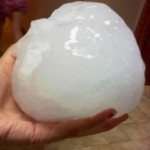 Before scientists learned how to predict the weather, and before the weather predicting equipment came into being, people often found themselves outside, without any place to get under cover, during some really bad storms. Such was the case on Monday, April 13, 1360…later dubbed Black Monday, when a hail storm killed approximately 1,000 English soldiers in Chartres, France. England and France were in the middle of the Hundred Years’ War. The war began in 1337, and by 1359, King Edward III of England was pushing forward to conquer France. In October he sent a massive force across the English Channel to Calais. The French wouldn’t fight back, but rather stayed behind protective walls that Winter, allowing the King Edward’s men to pillage the countryside.
Before scientists learned how to predict the weather, and before the weather predicting equipment came into being, people often found themselves outside, without any place to get under cover, during some really bad storms. Such was the case on Monday, April 13, 1360…later dubbed Black Monday, when a hail storm killed approximately 1,000 English soldiers in Chartres, France. England and France were in the middle of the Hundred Years’ War. The war began in 1337, and by 1359, King Edward III of England was pushing forward to conquer France. In October he sent a massive force across the English Channel to Calais. The French wouldn’t fight back, but rather stayed behind protective walls that Winter, allowing the King Edward’s men to pillage the countryside.
Then in April of 1360 King Edward’s forces burned the Paris suburbs and marched  toward Chartres. The night of April 13, while they were camped outside the town, planning a dawn attack, a sudden storm developed. Lightning struck, killing several soldiers, and hailstones began pelting the men, and scattering the horses. One man described it as “a foul day, full of myst and hayle, so that the men dyed on horseback” Two of the English leaders were killed and the troops panicked…they had no shelter from the storm. They were at it’s mercy. King Edward’s forces suffered heavy losses that some of the men saw as a sign from God, that they should not be fighting against France. King Edward was convinced that they needed to negotiate peace with the French, and on May 8, 1360, the Treaty of Bretigny was signed, marking the end of the first phase of the Hundred Years’ War. King Edward renounced all claims to the throne of France, but he was given control of the land in the north of the country. Nine years later, fighting resumed
toward Chartres. The night of April 13, while they were camped outside the town, planning a dawn attack, a sudden storm developed. Lightning struck, killing several soldiers, and hailstones began pelting the men, and scattering the horses. One man described it as “a foul day, full of myst and hayle, so that the men dyed on horseback” Two of the English leaders were killed and the troops panicked…they had no shelter from the storm. They were at it’s mercy. King Edward’s forces suffered heavy losses that some of the men saw as a sign from God, that they should not be fighting against France. King Edward was convinced that they needed to negotiate peace with the French, and on May 8, 1360, the Treaty of Bretigny was signed, marking the end of the first phase of the Hundred Years’ War. King Edward renounced all claims to the throne of France, but he was given control of the land in the north of the country. Nine years later, fighting resumed  when the King of France claimed that King Edward had not honored the treaty. the last phase of the Hundred Years’ War finally ended in 1453.
when the King of France claimed that King Edward had not honored the treaty. the last phase of the Hundred Years’ War finally ended in 1453.
Hailstones have long been known to be very deadly. The larger the stone, of course, the more deadly it is. Some have been known to crush the roofs of cars. The largest hailstone recorded in modern times was found in Aurora, Nebraska. It was seven inches in diameter, about the size of a soccer ball. Hail typically falls at about 100 miles per hour, which explains why getting hit with one can really hurt you, no matter how small the stone might be, and why huge hailstones would mean instant death.


Leave a Reply